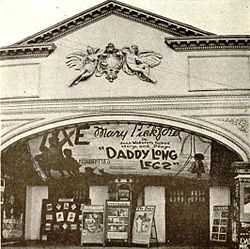This article needs additional citations for verification .(May 2025) |
Electra, Texas | |
|---|---|
 Liberty Theater, Electra, showing a Mary Pickford movie in 1919. | |
| Motto: "Wichita County's Best Kept Secret" | |
 Location of Electra, Texas | |
 | |
| Coordinates: 34°01′57″N98°55′12″W / 34.03250°N 98.92000°W | |
| Country | United States |
| State | Texas |
| County | Wichita |
| Area | |
• Total | 3.08 sq mi (7.98 km2) |
| • Land | 3.08 sq mi (7.97 km2) |
| • Water | 0.00 sq mi (0.01 km2) |
| Elevation | 1,227 ft (374 m) |
| Population (2020) | |
• Total | 2,292 |
| • Density | 740/sq mi (290/km2) |
| Time zone | UTC-6 (Central (CST)) |
| • Summer (DST) | UTC-5 (CDT) |
| ZIP code | 76360 |
| Area code | 940 |
| FIPS code | 48-22984 [3] |
| GNIS feature ID | 2410419 [2] |
| Website | www |
Electra is a city in Wichita County, Texas, United States. It is part of the Wichita Falls metropolitan statistical area. The population was 2,292 at the 2020 census., down from 2,791 in 2010. [4] Electra claims the title of Pump Jack Capital of Texas, a title made official by the state in 2001, [5] and has celebrated an annual Pump Jack Festival since 2002. [6] It was named in honor of Electra Waggoner, an heiress to the Waggoner Ranch. [7] Electra is also known for its Grand Theatre which was refurbished and now a functioning theater.


